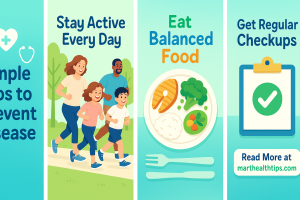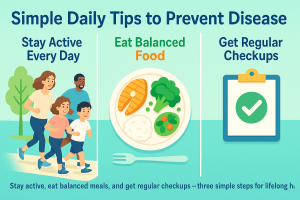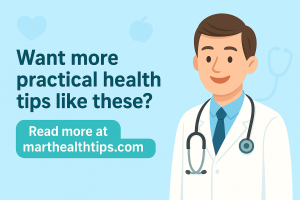
Prevent Before You Treat: The Smart Approach to Health
Disease Prevention: A Path to Healthier Living
Disease prevention is one of the most vital pillars of public health and personal well-being. In today’s fast-paced world, where chronic and infectious diseases are widespread, focusing on prevention is far more effective and economical than treatment. Disease prevention involves proactive strategies, lifestyle choices, and public health measures to reduce the risk of developing illnesses. By emphasizing prevention, we not only extend life expectancy but also improve the quality of life across all age groups.
Understanding Disease Prevention
Disease prevention is categorized into three main levels: primary, secondary, and tertiary prevention.

Primary Prevention focuses on stopping diseases before they occur. This includes vaccination, healthy diets, physical activity, hygiene, and avoiding harmful behaviors such as smoking or excessive alcohol use.
Secondary Prevention involves early detection and prompt intervention to halt the progression of a disease. Examples include regular screenings for high blood pressure, cancer, or diabetes.
Tertiary Prevention aims to manage and reduce the impact of established diseases by preventing complications and improving quality of life, such as physical therapy for stroke patients or insulin therapy for diabetics.
Why Is Disease Prevention Important?
Preventing diseases is more cost-effective than treating them. For example, the cost of preventing diabetes through healthy lifestyle changes is significantly lower than managing complications such as kidney failure, blindness, or amputations.
Moreover, prevention reduces the burden on healthcare systems, improves productivity, and contributes to national development by ensuring a healthier, more active population.
Key Strategies for Disease Prevention

1. Vaccination
Vaccines are among the most powerful tools in modern medicine. They protect against potentially deadly diseases such as measles, polio, influenza, hepatitis, and COVID-19. Ensuring that children and adults receive recommended immunizations is a key step in disease prevention.
2. Healthy Diet and Nutrition
A balanced diet rich in fruits, vegetables, whole grains, lean proteins, and healthy fats strengthens the immune system and reduces the risk of heart disease, diabetes, and obesity. Avoiding processed foods, excessive sugar, and salt also contributes to better health.
3. Physical Activity
Regular physical activity helps maintain a healthy weight, strengthens the heart and muscles, boosts mental health, and lowers the risk of many chronic diseases. Just 30 minutes of moderate exercise a day, like walking or cycling, can make a big difference.
4. Personal Hygiene
Good hygiene practices such as regular handwashing, proper food handling, and safe sanitation are essential in preventing the spread of infectious diseases like diarrhea, flu, and COVID-19.
5. Mental Health Awareness
Mental health is often overlooked in disease prevention. Stress, depression, and anxiety can weaken the immune system and contribute to physical illnesses. Seeking support, practicing mindfulness, and ensuring adequate rest are important preventive measures.
6. Regular Check-ups and Screenings
Annual health check-ups and age-appropriate screenings (like mammograms, cholesterol tests, and blood pressure monitoring) enable early detection of potential health issues, increasing the chances of effective treatment and reducing complications.
7. Avoiding Harmful Behaviors
Avoiding smoking, limiting alcohol, and staying away from recreational drugs significantly lowers the risk of diseases such as cancer, liver disease, and respiratory disorders.
Community and Government Role in Prevention
Individual actions alone are not enough. Governments and communities play a vital role by ensuring access to clean water, nutritious food, healthcare services, and health education. Public awareness campaigns, school-based health programs, and policies such as smoking bans or sugar taxes are all effective measures that promote public health and prevent diseases on a broader scale.

Conclusion
Disease prevention is not a one-time effort but a lifelong commitment. It requires awareness, discipline, and collective action. By embracing preventive measures, individuals can enjoy healthier lives, and societies can thrive with reduced healthcare costs and enhanced productivity. Whether through vaccinations, lifestyle changes, or public policy, prevention remains the most powerful medicine of all.